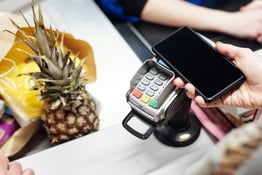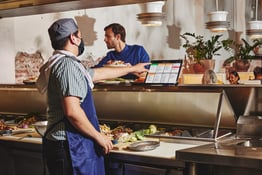You’ve been learning about your guests since the moment you flung open your restaurant doors and invited them inside. By now you know whether your clientele skews older or more Gen Z-ward, whether they spend more at lunch or at dinner, and whether they run through tequila or whiskey faster. But even if you know your regulars by name, you’re probably working more with anecdotes than with data. You may feel a little like Keanu in the opening scenes of The Matrix: plagued by the niggling notion that something deeper is just outside your grasp.
Even small business owners can, by now, tap into deeper wells of customer data. Guest knowledge is power. Power in turn is money, and money, according to Lana del Ray, is the reason we exist. She may be wrong about that, but it can definitely grow your business and your brand. To get actionable data, and to get it to pay real dividends, you’re going to need some quality analytic software. You may be familiar with the concept of a CRM (customer relationship management) platform — essentially a software that helps restaurants track their interactions with customers. As restaurant tech evolves, however, the big companies serving this market are driving more toward a CDP, or customer data platform. Used to its potential, you’ll begin to see the stream of data that underpin your entire business.
Without devolving into acronym soup, we’re going to drill into CDPs, their distinction from CRMs, and what these tools can offer a restaurant operator looking to create a more sophisticated view of their customer base. With that, you can build more durable relationships with those customers, and make better decisions on how to keep them coming back, happily.
CRM vs. CDP: What’s the difference?
To understand these tools, we spoke to representatives from the software companies Bloom Intelligence, SevenRooms, and Bikky. They explained that a CRM is a database that facilitates and tracks customer communications. You use it mainly for marketing and loyalty programs. A CDP, on the other hand, pulls in guest data from multiple sources and generates insights to create a fuller picture of overall guest behaviors. You can also collect information on specific guests so you can tailor the guest experience to their needs.
Those functions will see some crossover. Will Wilson, CEO of Bloom Intelligence, called the CDP “a superpowered CRM.” Bikky CEO Abhinav Kapur emphasized that CDPs enable you to get a read on every guest, not merely the ones who opt into marketing. “On average, only 20% to 30% of your customers are going to give you an email or a phone number to market to them,” he said. “But every guest does leave a breadcrumb of who they are, whether that’s through reservation booking, opting into wifi, or just swiping their credit card.” The idea is to sweep together data from online ordering, in-person visits, and payments to get as complete a picture as possible of each customer.
Why restaurants invest in CDPs
Make no mistake – marketing and loyalty are hugely important to restaurants. Set yourself up with a legacy platform like Mailchimp and you’ve got a great way to reach that aforementioned subset of customers who opt into emails. Those email platforms integrate with popular POS systems, reservation platforms, and WiFi portals, so you can capture additional contact information that way. Most of these platforms also integrate with other standalone systems. SevenRooms, for example, integrates with Mailchimp, so a restaurant that has seen good return on email marketing with that platform can keep the existing model while using SevenRooms for other purposes.
But Austen Asadorian, the VP of sales at SevenRooms, which bills itself as a full-service “guest management platform,” suggests investing in a one-stop shop. “You need to connect the dots,” Asadorian said. “You really want to have one end-to-end ecosystem to make sure that all the different channels are talking to each other, so that you can have optimal marketing automation.” If you’re using just one software, you don’t have to train your staff to use an array of different platforms.
That’s probably the biggest reason to invest in a CDP: the access to all the guest data you could want, all in one place. CDPs also use algorithms to predict guest behavior and provide you with takeaways that can inform your decisions.
How restaurants can get the most out of their CDP
Your first step is the same as when you get a new appliance, a fresh gadget, or pretty much anything with an on/off switch. Start by reading the manual. “The most common pushback we receive is, ‘Hey, you’re handing me the keys to the Ferrari, but I don’t know how to drive,’” Asadorian said of SevenRooms users. Your CDP company will probably have staff dedicated to helping new restaurants onboard and to continually help you troubleshoot. You’ll be happiest with your results if you geek out with them a bit.
Most CDPs help you understand guest behavior on two levels. They show you a general overview of what your guests do in aggregate. And they create individual profiles for specific customers whose details come via any of several channels. Wilson described Bloom Intelligence’s model this way: “We’re able to measure guest behavior as soon as someone comes into a restaurant — the WiFi captures location data, so it knows when a new guest has entered. At this point, it’s all anonymous. The platform measures the foot traffic and provides insights into metrics like dwell time, peak hours, return rate. If, at some point, the guest signs into the captive WiFi using their email address, then we can start collecting personalized data around that specific guest, and the platform creates a profile.” Other opt-in points include online ordering, engagement with social media, paying at the register. All these guest data converge on the platform, to create a profile of this specific customer.
That profile might consist of as few details as a name and a corresponding email address. Or it might get incredibly detailed, with information about birthdays and anniversaries, order frequency, food preferences, and dietary restrictions. Some of the data is collected automatically when a guest interacts with an opt-in point (and certain opt-ins are sneaky; depending upon your Facebook settings, your favorite restaurant may have a picture of you on file). Operators can also pull up profiles and add details and tags based on offline interactions. That is, by what your staff can notice and note.
“Having a feedback loop is considered a best practice in the restaurant business, especially in fine dining,” Asadorian said. “As a manager or operator, you should be training your staff to collect data on their guests. In most places with table service, servers are taking orders on a chit, and as they’re doing that they should be chatting with and learning more information about their guests. Are they there for a special event? Is somebody allergic to peppers? When a guest feeds you that nugget, you need to write it down. When I worked in high-end restaurants, part of the closing practices would be to take those chits and input any new updates that we learned from that day into our system. That data matters, because you need to service that guest accordingly.”
To that end, SevenRooms allows you to assign tags like “big tipper” and “alert GM” alongside auto-tags like “delivery regular” and “positive review.” (Yes, these platforms pull from Google and Facebook reviews as another source of data.) When you coordinate effectively, your regulars will find that anyone on staff can treat them familiarly, even if it’s a person they’ve not previously met.
How to market with a restaurant CDP
Once you have a sense of the individuals who visit your restaurant, you’re on the verge of unlocking the real power of the CDP, which is maintaining a meaningful connection with a person when they’re not in your restaurant. The key to this is specificity. Think of it this way: Do you prefer to get a bcc’ed blast email from your friend inviting you to their barbecue? Or do you prefer a text addressed to you, with a photo of you with your friend at their last party, with that invite? Which one makes you more excited to say yes?
CDPs can’t get quite that personal, but they do allow you to tailor your communications to a person’s likes and needs. Instead of simply collecting email addresses and blast-emailing everyone once a month, you can segment your customer list and send more personalized messages. “How many vegetarians are rolling their eyes at emails about the steak dinner?” Asadorian said. “How many non-wine-lovers are receiving wine pairing emails that just end up in the trash? If your aim is to persuade people to enjoy a wine dinner experience at your restaurant, shouldn’t you first start with the people you know like to drink wine at your restaurant?”
Once you understand your current customers broadly, the CDP can help you create “lookalike campaigns” on Facebook or Google. The premise there is, if your typical customer is recent college grad making under $50,000 a year who lives within two miles of your restaurant, you can allocate your ad budget to reach similar folks.
Another nifty facet of the CDP is its ability to influence review behavior. Bloom Intelligence, for instance, can fire off a message to guests shortly after they cash out, asking for an online review. “Once they make that review, you’re able to quickly respond to that review through automation,” Wilson said. “And you can actually pull those reviews and embed them into your website to showcase them. Without automation, dealing with reviews can be a lot of frustrating work, but a CDP minimizes the time and effort involved.” The value of positive reviews shows up directly on the bottom line. On the flip side, if someone goes to Yelp or Google to vent about a negative experience, you want to be able to reach out in a jiffy.
A CDP can also help you measure your marketing tactics. You may think your loyalty program is driving revenue; you can make sign-up acquisition your alpha and omega, but without data to back it up, you’re merely following a hunch. A CDP can show you a customer’s history before and after they joined the loyalty program, for instance, helping you determine whether the discounts you’re offering them are increasing or decreasing their profitability with each visit. You can also tease out broader demographic differences between your traditional customers as well as your loyalty customers. “You can really refine your strategy,” Kapur said, “once you see the data.”
The data can also reveal one when a customer may be drifting away from you. Bloom Intelligence for one has a “churn algorithm” that can predict when you’re starting to lose a regular customer, giving you an opportunity to market strategically to keep them returning. You can configure your CDP to flag a customer as “at risk” when frequency drops below a certain threshold, giving you the power to keep those existing guests, a cheaper and easier feat than converting a new guest.
“The algorithm looks at your visit behavior as well as your online behavior, and then collapses both into a frequency distribution,” Wilson said. “Then, if we haven’t seen you in awhile, we can send an email that says, ‘Hey so-and-so, here’s a free cookie, please come back.’ We’re seeing great returns on that strategy. Turns out that 38% of those guests walk back in the door.”
Going full galaxy-brain with your CDP
All of these functions have one thing in common, and it amounts to the bottom line when it comes to the value of a CDP: You end up with answers to questions you never thought to ask. Gradually you can see through the data to understand the hidden relationships your customers have with your establishment, and you can create a better experience — and a more profitable business — along the way.
“When you actually talk to restaurateurs who aren’t using this kind of software, they don’t have any way of knowing these super basic metrics, like how many unique guests they served last month,” Kapur said. “They know what their revenue is. They can look at how many checks they do through their POS on a monthly basis. But if they can’t distill that down into how many individual customers that is, that’s a problem. How much of your revenue comes from repeat customers? If you have four locations, how do those metrics differ across each location? Is there one location that is really good about getting new customers but terrible at keeping them? That’s not a marketing problem, that’s a service problem.”
By that same token, of course, a restaurant with great retention but poor acquisition could benefit from a traditional marketing push. Or, say you decide to raise prices to offset the cost of third-party delivery. Your CDP can help you monitor customer responses to the change.
With a CDP in place, you can get as geeky as you want with this data — assuming, of course, you have the time and headspace to really dig into it. You or another point person will need to be responsible for running the software and taking action on the insights generated. That may wind up being someone on staff, or a new hire. “Typically, it’s someone with an analytics title or a marketing title that focuses on the implementation and the usage of the product,” Kapur said. If there’s not currently someone at your restaurant with the word “marketing” in their title, you might not yet have the bandwidth to take full advantage of a CDP. But your experience may vary. It’s always going to be tempting to really go down the rabbit hole.
[Photo by Nicole Sabilia via Pexels]





